Sights and Activities
Below are the places we saw and activities completed while visiting Chile:
Puerto Natales
Torres del Paine National Park: We spent six days and five nights trekking in this Unesco Biosphere Reserve. We went from west to east along the famous ‘W’ trail, passing azure lakes, emerald forests, a radiant blue glacier, and superior views of different peaks, such as Los Cuernos and ended our trek with a spectacular view of the 2800m (9186 ft) granite peaks, Torres del Paine. Be sure to read more about this journey and other Patagonia adventure’s in our article.
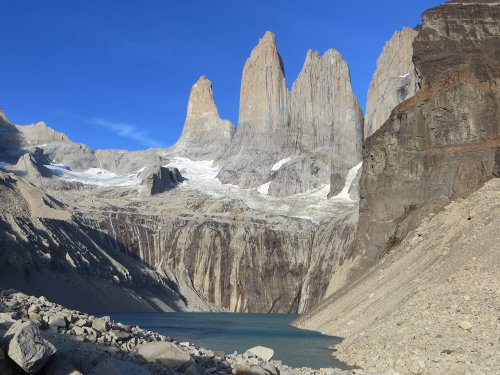
Navimag Ferry
We were really thrilled to spend time resting on this three-night, three-day ferry through Chile’s spectacular fjords and landscape from Puerto Natales to Puerto Montt. Unfortunately, the day before boarding the ferry, we received the devastating news that Gisela’s brother had passed away. We decided to continue with the journey since there were not very many other options to travel out of the deep South Patagonia. We boarded the ferry the first evening with the news that we were upgraded from a dorm room to a private room, which was great to hear considering our circumstance. The days on the ferry were a little similar to our mood, gloomy and low-spirited. The weather conditions and a medical emergency made the ferry arrive a day late and therefore we were required to spend another night on the boat. There were a few occasions where the climate allowed us to go outside, view the beautiful surroundings, the sunset, and the full moon. We also had the interesting opportunity to see the captain’s quarters where all the navigation takes place. We finally arrived to Puerto Montt after almost 96 hours on the ferry.

Puerto Montt
We spent a day in this seaside city walking through the streets of the city center and the coastal boardwalk. We had an opportunity to view the whole city from a beautiful lookout point and also enjoyed a delicious seafood lunch in the local market. Unfortunately, we could not spend more time in the city and the surroundings due to the flight we had to catch in Santiago.
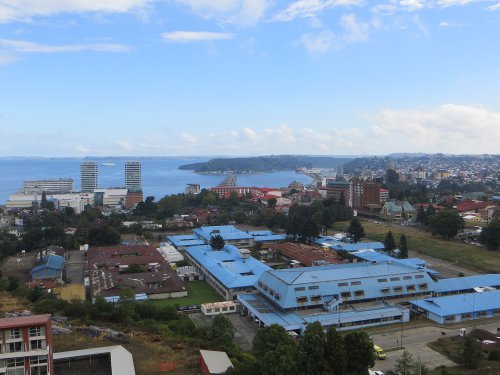
Villarrica and Pucon
We split a day between these two distinct towns. Villarrica is a real Chilean town as opposed to the resort town of Pucon. Both lie along opposite sides of a picturesque lake with amazing views of the 2847m (9340 ft) high Villarrica Volcano. We spent a couple hours walking in both towns, but the highlight in each settlement was hiking on a cloudless, beautiful day along the lake with a clear view of the volcano.
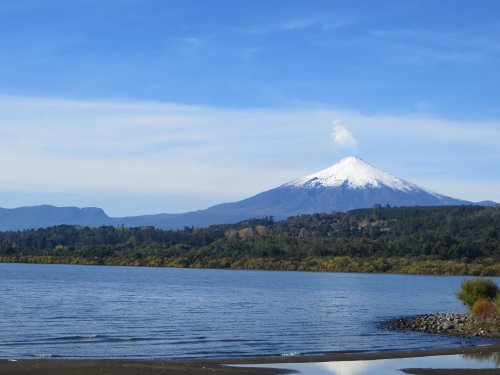
Temuco
Pinto Fair (Municipal Market): we took a look around this market where we bought vegetables and meat.
Cerro Ñielol: we hiked up this hill that sits among native forest with views of the city. It was here in 1881, that Mapuche leaders ceded land to the colonists to found the city.

Valdivia
Costanera: walked along the riverfront viewing the playful sea lions that wait to be fed in the Feria Fluvial.
Feria Fluvial: a lively riverside market, where vendors sell fresh fish, meat, and produce. Sea lions hang around the market waiting for the vendors to throw the fish remains at them.

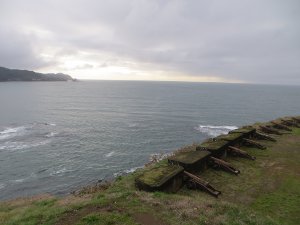
Mercado Municipal: this three-story building is filled with seafood restaurants. We had a scrumptious lunch with a nice river view.
Castillo de Niebla: located in the Coral Bay, this Spanish fort/castle was one of the most important for Valdivia in the colonial times. It is now a tourist attraction with a museum with the history of the site that was declared a national monument in 1950. The area offers great views of the river, ocean, and cliffs.
Pelequen
We spent 11 days in a family farm volunteering as WWOOFers. While at the farm, we performed various maintenance tasks, cared for various animals, and learned and helped to make grape chicha. Our host also taught us how to make several Chilean dishes. To read about our time in the farm, be sure to read our article.

Santa Cruz
Museo Colchagua: this museum contained several exhibits that varied widely from several fossils, a pre-Columbian ceramic collection, Chilean history, weapons, religious artifacts, Mapuche silver, huasos (cowboy) gear, and an exhibit on El Gran Rescate (The Great Rescue), showing objects, photos and films related to the October 2010 rescue of the 33 miners trapped 700m (2300 ft) underground in North Chile.

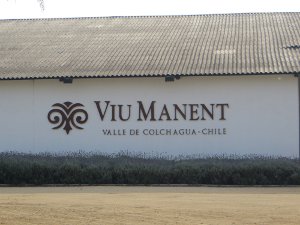
Viu Manent Winery: we went for a wine tasting in this winery owned by the Viu family. It was founded in 1935 when the Catalonian immigrant Miguel Viu-García and his two sons Agustín and Miguel Viu-Manent founded Bodegas Viu in Santiago de Chile. They bottled and sold wine on the local market under the “Vinos Viu” brand. In 1966 Miguel Viu Manent fulfilled his long-time dream of making his own wines.
Santiago
- Museo de la Memoria y los Derechos Humanos: this well-organized museum opened in 2010, exposes the terrifying human rights violations and large-scale ‘disappearances’ that took place under Pinochet’s military government between the years of 1973 and 1990. Learning about the 40,000 victims subjected to torture and execution was frightening, but a must to help contextualize the country’s unsettled history.
Barrio Paris-Londres: a neighborhood lined with European-style town houses built in the 1920’s and with two intersecting cobbled streets. One of the buildings in the neighborhood is Londres 38, a building that served as a torture center during Pinochet’s government.
Centro Cultural Palacio La Moneda: located beneath the Palacio de la Moneda, this cultural space contains two large temporary exhibition spaces with various art work when we visited, a fair-trade crafts shop, and a few cafes.
Palacio de la Moneda: or literally translating to Palace of the Coin, it is the official home of Chile’s presidential offices are located in this neoclassical building, designed by Italian architect Joaquín Toesca in the late 18th century, and was originally the official mint.
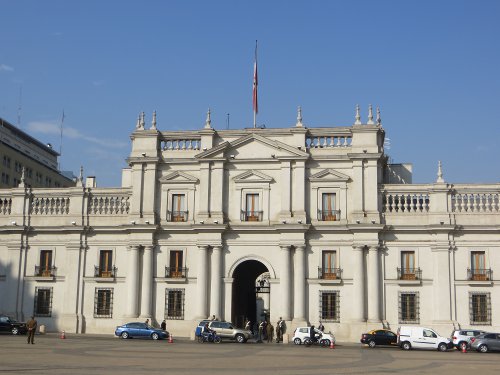

Plaza de Armas: since the city’s founding in 1541, this plaza has been its symbolic heart. Now it hosts a fountain celebrating the liberator Simón Bolívar, shaded by more than a hundred Chilean palm trees.
Catedral Metropolitana: located in the Plaza de Armas is this neoclassical cathedral built between 1748 and 1800.
Mercado Central: this fish market is a classic for seafood lunches and that is exactly what we did.
Estacion Mapocho: once used for rail services this station severed earthquake damage, which that along with decay of the rail system led to its closure. It has now been reincarnated as a cultural center. The soaring cast-iron structure of the main hall was built in France and then assembled in Santiago behind its stone facade.
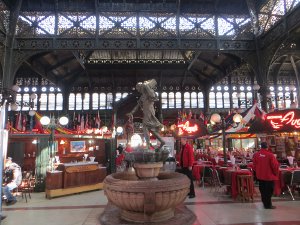

Cementerio General: a city of tombs where Salvador Allende’s grave and the Memorial del Detenido Desaparecido y del Ejecutado Político, a memorial to the ‘disappeared’ of Pinochet’s dictatorship, lies.
La Chascona: we took a self-guided audio tour of the poet’s, Pablo Neruda, secret hideaway where he would spend time with his mistress Matilde Urrutia. He built La Chascona, loosely translated in Chilean Spanish as ‘messy hair,’ inspired by her unruly curls. We walked through the bohemian designed house listening to the poet’s life story and viewing the rooms and artifacts, such as the dining room modeled after a ship’s cabin, the living room as a lighthouse, colored glasses, shells, and artwork.
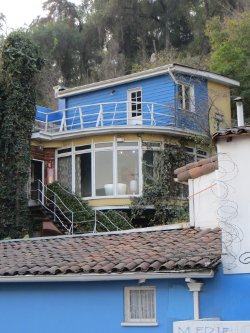

Centro Gabriela Mistral: this cultural center is named after a Chilean poet, Gabriela Mistral, the first Latin American woman to win the Nobel Prize in Literature. The center is home to two large exhibition spaces, outdoor plazas, a delightful bookstore, a café, and a small outdoor antique fair.
Valparaiso
Plaza Sotomayor: located in the heart of the city, the plaza is dominated by the impressive, blue Edificio de la Comandancia Naval (Naval Command Building), and in the middle of the square lays the Monumento a los Héroes de Iquique, a mausoleum paying tribute to Chile’s naval martyrs.
Ascensors: one of the best things we did in this city was walk the city streets full of murals and ride on some of the ascensores (funiculars) with great views of the cerros (hills) and colorful houses. The city has 15 ascensores built between 1883 and 1916, which we were able to ride on four, Ascensor Peral, Artilleria, Cordillera, and Baron, and saw the oldest funicular, Ascensor Concepcion.
Palacio Baburizza: this art nouveau building dates from 1916, which now houses the Museo de Bellas Artes (Fine Arts Museum), but we did not enter.
Paseo Atkinson: we walked through this walkway located on Cerro Concepcion with views of typical colorful Valparaiso houses.
Valparaiso Carcel: we were fortunate to take a peek inside this jail turned cultural center located on top of Cerro Carcel. The space was redesigned magnificently and a great example of reusing the area for the benefit of the people.
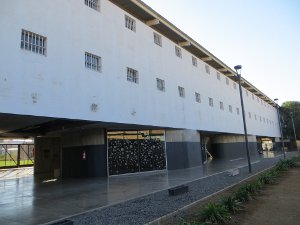
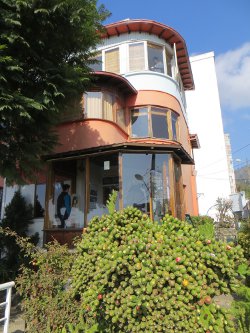
La Sebastiana: located in the neighborhood of Bellavista, we took a self-guided audio tour of another of Pablo Neruda’s houses. The views of the city and the harbor from any of the five stories of the house are spectacular. And it would not be a Neruda house without the poet’s collections of ship’s figureheads, vintage furniture, and artworks by his famous friends.
Museo a Cielo Abierto: an open-air museum featuring twenty large, colorful murals that dot the walkways. The murals were created between 1969 and 1973 by students from the Universidad Católica’s Instituto de Arte.
Paseo 21 de Mayo: located on Cerro Artilleria, this walkway has remarkable views of the port full of cranes and containers.
Plaza Bismark: this plaza is located on Cerro Carcel with panoramic views of the bay. We arrived at dusk to get a view right before dark and to see the city gleaming at night.
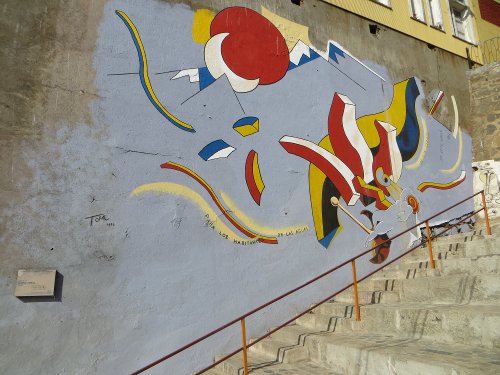
Parque Cultural de Valparaiso: we were privileged to find out that this cultural center had performances during our stay. We attended two presentations the first was a monologue, L’america, about Italian immigrants to Argentina. The second was a play called ‘Colibri, Un Viaje del Alma’ (Hummingbird, A Voyage from the Soul) about discrimination in general, but more specifically of disabled people.
Isla Negra: the third, of three, of Pablo Neruda’s house that we visited is located in a spectacular ocean view setting. This was understandably Pablo Neruda’s favorite house. The poet built the house when he became rich in the 1950’s. It was stormed by soldiers just days after the 1973 military coup when Neruda was dying of cancer. The house contains 80% of Neruda’s collection which includes extraordinary collections of bowsprits, ships in bottles, nautical instruments, and wood carvings. Neruda’s tomb is also here, alongside that of his third wife, Matilde. The only unfortunate part of our visit was that the day we arrived was a national holiday where museums around the country were free, which was a good thing, but the entrance did not include the audio guides that were included in his other houses, so we were not able to listen to the facts of the house.
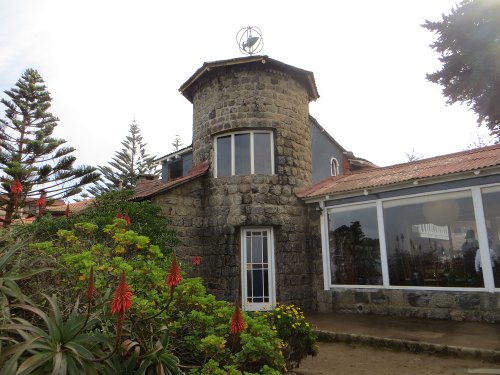

Mirador Diego Portales: another of many of the city’s viewpoints located on Cerro Baron. From here we were able to see sweeping views of the city’s colorful cluttered houses.
Congreso Nacional: one of the city’s only modern landmarks is this controversial National Congress. Its roots lie in Pinochet’s presidency both literally and legislatively: it was built on one of his boyhood homes and mandated by his 1980 constitution, which moved the legislature away from Santiago.
Viña del Mar
Museo de Arqueologia e Historia Francisco Fonck: this museum specializes in Rapa Nui (Easter Island) archaeology and also contains exhibits on other indigenous groups, Chilean natural history, and Mapuche silverwork.


Parque Quinta Vergara: the city’s nickname, the Garden City, proves just at this magnificently landscaped public park, featuring plants from all over the world.
San Pedro de Atacama
Below are the activities we performed and the sights we visited in the Atacama Desert, but to read more about our time there and see pictures and videos, be sure to visit our article.
Iglesia San Pedro: this church was closed to the public due to the restoration process, except at certain times when they give tours of the process. Fortunately, we were walking by at one of these times. We were able to see this 17th-century colonial church built with indigenous materials: chunky adobe walls and a ceiling made from cardon (cactus wood) that is held by hefty leather straps.
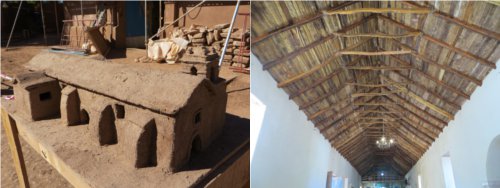

Museo Gustavo Le Paige: a museum about the local indigenous groups with several indigenous craft, fascinating malformed skulls and mummy replicas, an extraordinary collection of shamanic paraphernalia for preparing, ingesting, and smoking hallucinogenic plants, and much more.
Valle de la Luna: we took a tour of the Valley of the Moon named after its lunar-like landforms: passing by Valle de la Muerte (Death Valley); different rock formations such as Tres Marias, Anfiteatro, and Piedra del Coyote; salt caves; and watched the sunset from Cari’s viewpoint with views of the Andes Mountain Range, the Salt Mountain Range, and Domeico Mountain Range.
El Tatio Geysers: we took a tour of these geysers at sunrise to see some surreal sights. It was freezing cold when we arrived at 4300m (14,107 ft) above sea level at the world’s highest geyser field. We were also able to take a dip into a natural hot spring.
Mountain Biking: Sal biked for almost 5 hours in the Catarpe Valley and entered the Quebrada del Diablo (Devil’s Gorge) where the serpentine single track was a dream.
Arica
Iglesia San Marcos: this gothic-style church was designed by Alexandre Gustave Eiffel in 1875.

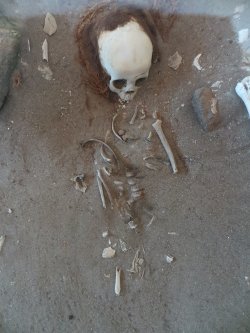
Museo de Sitio Colon 10: this museum displays 32 excavated Chinchorro mummies that are believed to have 5,000 years. The mummies are exhibited as they were found under a glass that one can walk over.
El Morro de Arica: looming 110m (360 ft) over the city, we reached this rock cliff by a footpath that displays panaromic views of the city and beaches.
Aduana de Arica: Alexandre Gustave Eiffel also designed this former customs house located at General Baquedano Park, which used to be on the harbor before the landfill extension.
Playa La Lisera: we walked to this popular white-colored beach, where locals surf, windsurf, fish, and snorkel.

